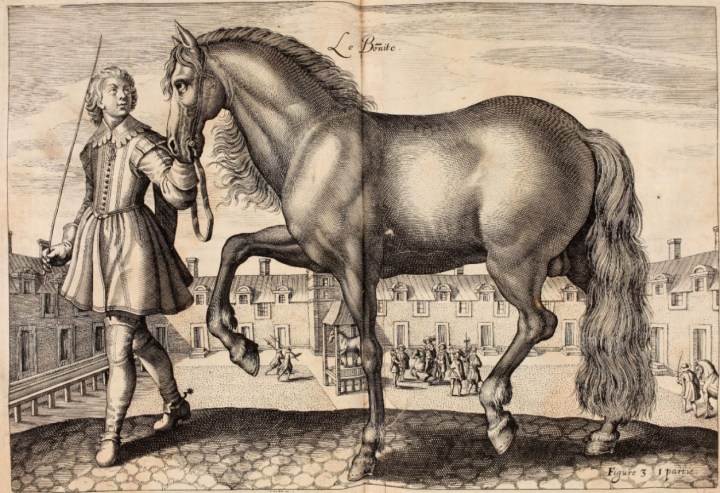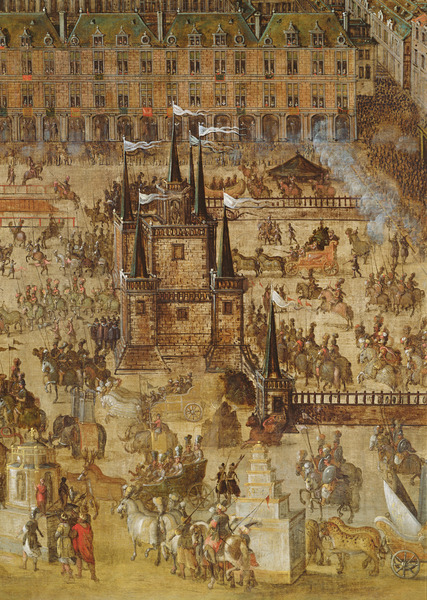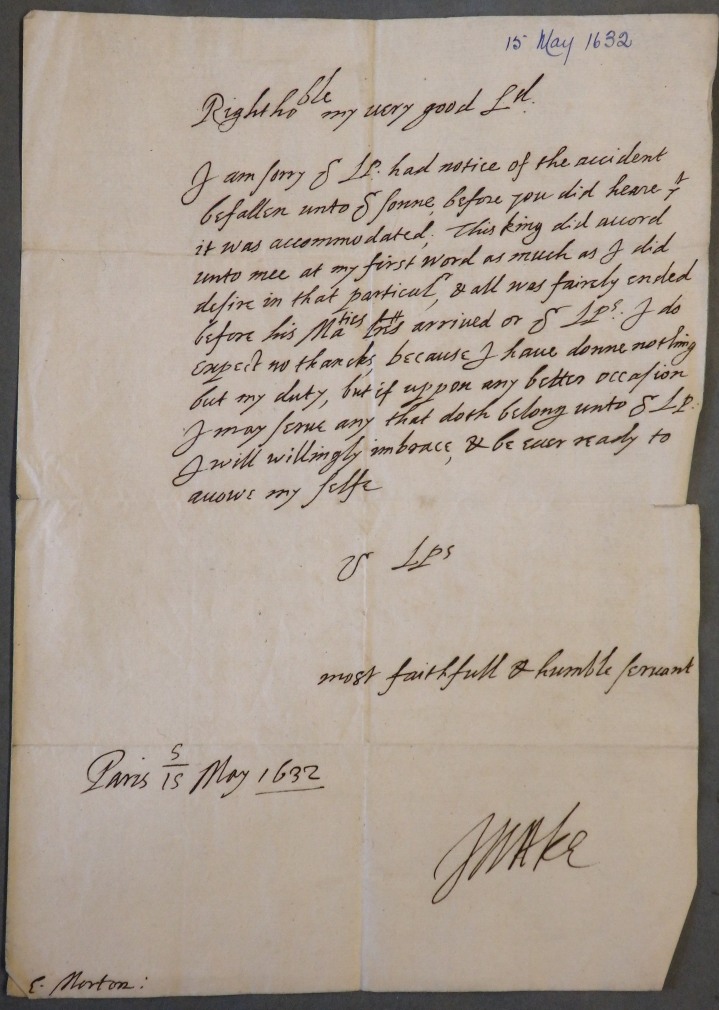Scottish aristocrats went to France to learn French conversation and the accomplishments of dancing, fencing and riding horses in manège in the Parisian riding academies. Meeting and making friends with French aristocrats was a bonus and tutors hoped their pupils would get an audience with the king and kiss his hand.

Antoine de Pluvinel’s L’Instruction du Roy en l’exercice de monter à cheval.
Detailed information on these trips comes from the tutors’ anxious letters back home and from the careful accounts they made. One of the earliest is an account book for a trip in 1611-12 for Alexander Seton, later Earl of Eglinton (1588-1561), a younger son of Robert Earl of Winton. [1]
Alexander’s coffers were taken to Leith. He bought sugar confectionery for the voyage and crossed the Forth to Burntisland, sailing to Dartmouth and then to Le Conquet and on to La Rochelle. He stayed there a while buying books and clothes, and gave a lavish dinner to Scots from the College. In August he went to Mirambeau, and north to Châtellerault and Blois where he played tennis. Alexander played a lot of tennis. He was at Bordeaux on 26 August, and in September he stayed with John Welsh the deposed minister of Ayr and his wife Elizabeth at Jonzac. Alexander went on to Poitiers.
The tutor, whose never gives his name, fell sick of fever on 11 August and was nursed at a ‘medicine house’ a league from Jonzac for fortnight under the care of the Welshes. His care cost 41 livre tournois 12 sous. The fever was relieved by bleeding ‘bayth beffoir none and eftirnone’. [2]
The first weeks of travel and experience of life in France were preliminary to the more intense and expensive programme in Paris. On 28 September 1611 he finally arrived in Paris and stayed at the ‘phoburge of St Jacques’ subsequently taking lodgings with Monsieur Massicot at St Germanes. On 4 October he enrolled at fencing school under a master called Anglois and dancing school with Bret. On the 11 October he started ‘volteidging’ with another master, another riding exercise involving a bounding turn – ‘which cunning riders teach their horses’, Cotgrave.
More clothes were bought, others especially hats were repaired or refurbished. Alexander got through quantities of shoes and fencing shoes. Extra fuel was needed to get through the great frost. Meanwhile the tutor was sick again requiring bleeding by Monsieur Prymrois. Alexander bought a lute to learn on, then more lute strings, the lute was mended and on 4 March 1612 an Italian music teacher engaged. He bought a book by Du Plessis Mornay for 45 sous and several items to furnish his study.
Alexander and his tutor ‘flitted’ from the Croix-Blanc to another pension, where they were entertained one night by a juggler. When a companion Master Gib returned to Scotland, Alexander was compelled to pay his share for missing silver spoons. He also contributed money to help Drummond the prisoner, who was probably another Scottish gentleman. There were also Scottish beggars including the boy Stewart who was, it seems, also Italian.
At the manège Alexander was joined by Alexander Stewart Lord Garlies, James Haitlie of Mellerstanes, and Sir William Ker. Alexander also spent time with ‘lord Colving’, James Colville Lord Colville of Culross. He went to see the relics of St Denis. Once he went with Ker to the ballet. They went to bear baiting twice and on Shrove Tuesday bought ‘fouls’ for cock-fighting (a Fasternis tradition observed in Scotland). On Thursday 5 April 1612 they saw the triumph of the Castle of Happiness for the Habsburg double engagement at the Place Royale.

The Place Royale and the Carrousel in 1612, Musee de la Ville de Paris
Alexander Seton returned to Scotland to became the Earl of Eglinton in 1612. He married Anna Livingstone who had been brought up with Princess Elizabeth at Linlithgow and Coombe Abbey. [3] Their younger son was in Paris in 1633 and enrolled with same fencing master Monsieur Anglois. He also took maths classes. [4]
John Schaw took Henry and Alexander Erskine, two sons of the Earl of Mar, to France in December 1616. They went to Bourges to meet their grandmother, Catherine de Balsac widow of Esmé Stewart, Duke of Lennox, who wept with joy for a day to see them. They saw their aunt Gabrielle Stewart at the convent at Glatigny, giving the nun a present of a watch from their mother Marie. Perhaps they had bought the watch in Paris. Their trip is documented in detail by letters printed by the Historical Manuscript Commission. After some money trouble, resolved by Philip Burlamachi, and delay caused by the death of the Master of Roxburghe, the boys continued on to Paris. Henry Erskine, the elder son, detailed the death of Concino Concini, 1er Marquis d’Ancre. The Earl of Morton lodged in the same house in Paris.

Gabrielle Stewart’s letter to her sister, after her nephews’ visit, NLS MS. 5070.
In the summer they returned to Bourges to see their aunt grandmother again, in Morton’s company. The laird of Pitmillie died of a pox and the French doctors had been incredulous that the Scots recommended the bezoar stone for him. The Earl of Angus was also in Bourges and Henry wrote that the number of Scots in the town had hampered their learning French. In October they travelled to Orleans and then Saumur. Henry said the winter season in Paris would be the stamp of all their exercise, after a trip to Venice. Schaw wrote they had spent a year learning dancing, eight months in fencing, and they learnt to play tennis and the lute, proposing a trip to Florence. Mar sent them a letter of introduction to Sir Henry Wotton in Venice and a reccomendation from Philippe de Plessis Mornay. (Along the way, the Bishop of Vaison suggested a marriage for Alexander, to his ‘niece’, daughter of Lord Madderty who was said to resembe Alexander’s sister, Anne Erskine, Countess of Rothes. In 1624 Elizabeth of Bohemia suggested her gentlewoman Madge Croft as a bride for Henry, as Lisa Jardine notes.) Schaw wrote of the abominations of the church in Rome. They were in London in the summer of 1620. [5]
Two sons of William Douglas 7th Earl of Morton enjoyed almost the same experiences as Alexander, one recalled early in advance of Buckingham’s assault on La Rochelle in 1627 (for which his father was the principal recruiter of troops in Scotland), the other imprisoned in the Bastille (for an unknown offence) and released at the intervention of the ambassador Isaac Wake and the prompt action of Henry de Vic. A spell in Bastille was a commonplace exploit, according to a historian of the Grand Tour, John Stoye.
In 1633 this member of the Douglas family went on to Italy and during the plague in Florence stayed at the Villa di Castello with Henry Murray, possibly an older brother of Anne Lady Halkett. Murray wrote of their boredom during the plague, and that were granted an audience with Grand Duke on receipt of Morton’s last letter, and would be grateful for another letter as excuse to repeat this experience.
At the Villa di Castello they lived like princes at the expense of Grand Duke Ferdinando II who:
‘did nott only offer us one of our own houses to live in for more securitie: but has made us actually possessors of one of the cheefest & principall pallaces he has, which has the rarest & finest gardens in Italy: and here we now live like Princes’ [6]

Isaac Wake to Morton, 5/15 May 1632, NRS GD150
Some parents were less keen on Italy. In 1645 Charles Erskine of Cambuskenneth prevented his son travelling on from Marseilles by instructing John Clerk (of Penicuik) to refuse him credit. Clerk wrote that he had deterred William Erskine from his dangerous Italian voyage, while William continued to beg him for money. [7]
Sources
[1] National Records of Scotland GD3/6/2 nos. 8 & 11. ‘account due to chirurgeon and for medicine August 1611, and account of disbursements of the sum of 3000 merks travelling and personal expenses’ 1611-12.
[2] Anecdotes of Welsh’s medical care of the Master of Ochiltree became controversial, J. Young, Life of John Welsh, minister of Ayr (Edinburgh, 1866), 383: J. Kirkton, The History of the Life and Death of Mr. John Welch, Minister of the Gospel at Air (Glasgow, 1735), 27-8.
[3] The history of the house of Seytoun to the year M.D.LIX. by Sir Richard Maitland with the continuation by Alexander Viscount Kingston, to M.DC.LXXXVII (Glasgow, 1829), 70-1.
[4] W. Fraser, Memorials of the Montgomeries, vol.1 (Edinburgh, 1859), 230-1.
[5] HMC Mar & Kellie, 2 (1930), 72-93 infra: National Library of Scotland MS. 5070 no. 3, Gabrielle Stewart to Marie Stewart, 28 January 1617: Lisa Jardine, Temptation in the Archive, 4-5.
[6] Morton papers NRS GD150 & NLS MS.78-90, MS. 84 no. 40, 30 April 1633.
[7] NLS MS. 5155 nos. 71-88, no. 46 is a fragment of a French itinerary from 1643, and no. 49 discusses the receipt of a letter from Paris via Clerk with broken seals. For a discussion of these letters and their context, see: Williams, Mark R.F. ‘The inner lives of early modern travel’, Historical Journal 62 (2) (2019) , pp. 349-373.